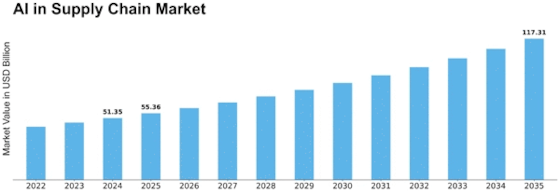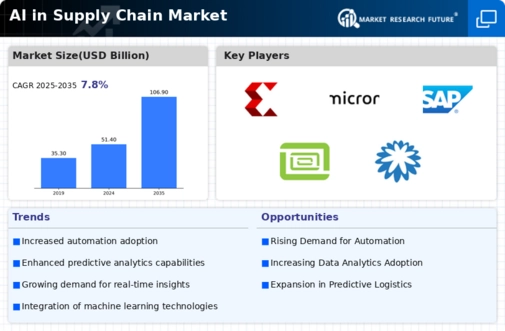-
Executive Summary
-
Scope of the Report
-
Market Definition
-
Scope of the Study
-
Research Objectives
-
Markets Structure
-
Research Methodology
-
Market Dynamics
-
Market Drivers
- Increasing market growth of E-commerce
- Increasing growth in big data technology
- High demand for advanced solutions for transparency in supply chain process
-
Market Restraints
- Lack of technical expertise
-
Market Opportunities
- Increasing adoption of cloud-based software modules by supply chain industry
- Rising trend of deploying automation solutions by industries into their operations
- Growth in industry 4.0
-
Market Challenges
- Data privacy
- Lack of connected systems in sectors such as retail and logistics
-
Value Chain analysis
-
Porter’s Five Forces Analysis
- Threat of New Entrants
- Bargaining Power of Buyers
- Threat of Substitutes
- Segment Rivalry
- Bargaining Power of Suppliers
-
Market Alerts
-
Impact Analysis of Emerging Technologies
-
Use Cases
- Chatbots
- Autonomous Vehicles
- Supplier Relationship Management
-
Government/Industry Norms and Regulations
-
Artificial Intelligence (AI) in Supply Chain Market by Component
-
Introduction
-
Hardware
- Market Estimates & Forecast, 2023-2030
- Market Estimates & Forecast by Region, 2023-2030
- Processors
- Memory
- Network
-
Artificial Intelligence (AI) in Supply Chain Market by Technology
-
Introduction
-
Machine Learning
- Market Estimates & Forecast, 2023-2030
- Market Estimates & Forecast by Region, 2023-2030
-
Natural Language processing (NLP)
- Market Estimates & Forecast, 2023-2030
- Market Estimates & Forecast by Region, 2023-2030
-
Context-aware computing
- Market Estimates & Forecast, 2023-2030
- Market Estimates & Forecast by Region, 2023-2030
-
Computer Vision
- Market Estimates & Forecast, 2023-2030
- Market Estimates & Forecast by Region, 2023-2030
-
Artificial Intelligence (AI) in Supply Chain Market by Deployment
-
Introduction
-
On-premise
- Market Estimates & Forecast, 2023-2030
- Market Estimates & Forecast by Region, 2023-2030
-
On-cloud
- Market Estimates & Forecast, 2023-2030
- Market Estimates & Forecast by Region, 2023-2030
-
Hybrid
- Market Estimates & Forecast, 2023-2030
- Market Estimates & Forecast by Region, 2023-2030
-
Artificial Intelligence (AI) in Supply Chain Market by Applications
-
Introduction
-
Fleet management
- Market Estimates & Forecast, 2023-2030
- Market Estimates & Forecast by Region, 2023-2030
-
Warehouse management
- Market Estimates & Forecast, 2023-2030
- Market Estimates & Forecast by Region, 2023-2030
-
Supply chain planning
- Market Estimates & Forecast, 2023-2030
- Market Estimates & Forecast by Region, 2023-2030
-
Logistics & shipping
- Market Estimates & Forecast, 2023-2030
- Market Estimates & Forecast by Region, 2023-2030
-
Supplier relationship management
- Market Estimates & Forecast, 2023-2030
- Market Estimates & Forecast by Region, 2023-2030
-
Risk management
- Market Estimates & Forecast, 2023-2030
- Market Estimates & Forecast by Region, 2023-2030
-
Others
- Market Estimates & Forecast, 2023-2030
- Market Estimates & Forecast by Region, 2023-2030
-
Artificial Intelligence (AI) in Supply Chain Market by Vertical
-
Introduction
-
Aerospace
- Market Estimates & Forecast, 2023-2030
- Market Estimates & Forecast by Region, 2023-2030
-
Automotive
- Market Estimates & Forecast, 2023-2030
- Market Estimates & Forecast by Region, 2023-2030
-
Retail
- Market Estimates & Forecast, 2023-2030
- Market Estimates & Forecast by Region, 2023-2030
-
Manufacturing
- Market Estimates & Forecast, 2023-2030
- Market Estimates & Forecast by Region, 2023-2030
-
Food & beverage
- Market Estimates & Forecast, 2023-2030
- Market Estimates & Forecast by Region, 2023-2030
-
Consumer electronics
- Market Estimates & Forecast, 2023-2030
- Market Estimates & Forecast by Region, 2023-2030
-
Others
- Market Estimates & Forecast, 2023-2030
- Market Estimates & Forecast by Region, 2023-2030
-
Artificial Intelligence (AI) in Supply Chain Market by Region
-
Introduction
-
North America
- Market Estimates & Forecast by Country, 2023-2030
- Market Estimates & Forecast by Component, 2023-2030
- Market Estimates & Forecast by Technology, 2023-2030
- Market Estimates & Forecast by Deployment, 2023-2030
- Market Estimates & Forecast by Applications, 2023-2030
- Market Estimates & Forecast by End-Users, 2023-2030
- US
- Mexico
- Canada
-
Europe
- Market Estimates & Forecast by Country, 2023-2030
- Market Estimates & Forecast by Component, 2023-2030
- Market Estimates & Forecast by Technology, 2023-2030
- Market Estimates & Forecast by Deployment, 2023-2030
- Market Estimates & Forecast by Applications, 2023-2030
- Market Estimates & Forecast by End-Users, 2023-2030
- Germany
- France
- Italy
- Spain
- UK
- Rest of Europe
-
Asia-Pacific
- Market Estimates & Forecast by Country, 2023-2030
- Market Estimates & Forecast by Component, 2023-2030
- Market Estimates & Forecast by Technology, 2023-2030
- Market Estimates & Forecast by Deployment, 2023-2030
- Market Estimates & Forecast by Applications, 2023-2030
- Market Estimates & Forecast by End-Users, 2023-2030
- China
- India
- Japan
- Singapore
- Rest of Asia-Pacific
-
Rest of the World
- Market Estimates & Forecast by Country, 2023-2030
- Market Estimates & Forecast by Component, 2023-2030
- Market Estimates & Forecast by Technology, 2023-2030
- Market Estimates & Forecast by Deployment, 2023-2030
- Market Estimates & Forecast by Applications, 2023-2030
- Market Estimates & Forecast by End-Users, 2023-2030
- Middle East & Africa
- South America
-
Competitive Landscape
-
Key Players Market Share Analysis, 2020/2020 (%)
-
Competitive Benchmarking
-
Key Developments Analysis, 2020/2020
- Mergers & Acquisition
- Product Developments
- Business Expansion
- Partnerships & Collaborations
- Agreements
-
Company Profiles
-
Nvidia Corporation
- Company Overview
- Product/Business Segment Overview
- Financial Updates
- Key Developments
- SWOT Analysis
- Key Strategy
-
IBM corporation
- Company Overview
- Product/Business Segment Overview
- Financial Updates
- Key Developments
- SWOT Analysis
- Key Strategy
-
Intel Corporation
- Company Overview
- Product/Business Segment Overview
- Financial Updates
- Key Developments
- SWOT Analysis
- Key Strategy
-
Xilinx, Inc.
- Company Overview
- Product/Business Segment Overview
- Financial Updates
- Key Developments
- SWOT Analysis
- Key Strategy
-
Samsung Electronics
- Company Overview
- Product/Business Segment Overview
- Financial Updates
- Key Developments
- SWOT Analysis
- Key Strategy
-
Microsoft Corporation
- Company Overview
- Product/Business Segment Overview
- Financial Updates
- Key Developments
- SWOT Analysis
- Key Strategy
-
Micron Technology
- Company Overview
- Product/Business Segment Overview
- Financial Updates
- Key Developments
- SWOT Analysis
- Key Strategy
-
SAP SE
- Company Overview
- Product/Business Segment Overview
- Financial Updates
- Key Developments
- SWOT Analysis
- Key Strategy
-
Oracle Corporation
- Company Overview
- Product/Business Segment Overview
- Financial Updates
- Key Developments
- SWOT Analysis
- Key Strategy
-
Logility, Inc.
- Company Overview
- Product/Business Segment Overview
- Financial Updates
- Key Developments
- SWOT Analysis
- Key Strategy
-
Amazon
- Company Overview
- Product/Business Segment Overview
- Financial Updates
- Key Developments
- SWOT Analysis
- Key Strategy
-
LLamasoft, Inc
- Company Overview
- Product/Business Segment Overview
- Financial Updates
- Key Developments
- SWOT Analysis
- Key Strategy
-
Conclusion/Recommendations
-
-
LIST OF TABLES
-
Artificial Intelligence (AI) in Supply Chain Market, by Region, 2023-2030
-
North America: Artificial Intelligence (AI) in Supply Chain Market, by Country, 2023-2030
-
Europe: Artificial Intelligence (AI) in Supply Chain Market, by Country, 2023-2030
-
Asia-Pacific: Artificial Intelligence (AI) in Supply Chain Market, by Country, 2023-2030
-
Rest of the World: Artificial Intelligence (AI) in Supply Chain Market, by Country, 2023-2030
-
North America: Casino Management System Component Market, by Country, 2023-2030
-
Europe: Casino Management System Component Market, by Country, 2023-2030
-
Asia-Pacific: Casino Management System Component Market, by Country, 2023-2030
-
Rest of the World: Casino Management System Component Market, by Country, 2023-2030
-
Global Casino Management System Component Market, by Region, 2023-2030
-
North America: Casino Management System Component Market, by Country, 2023-2030
-
Europe: Casino Management System Component Market, by Country, 2023-2030
-
Asia-Pacific: Casino Management System Component Market, by Country, 2023-2030
-
Rest of the World: Casino Management System Component Market, by Country, 2023-2030
-
Global Casino Management System Applications Market, by Region, 2023-2030
-
North America: Casino Management System Applications Market, by Country, 2023-2030
-
Europe: Casino Management System Applications Market, by Country, 2023-2030
-
Asia-Pacific: Casino Management System Applications Market, by Country, 2023-2030
-
Rest of the World: Casino Management System Applications Market, by Country, 2023-2030
-
-
LIST OF FIGURES
-
Global Artificial Intelligence (AI) in Supply Chain Market Segmentation
-
Forecast Methodology
-
Porter’s Five Forces Analysis of Global Artificial Intelligence (AI) in Supply Chain Market
-
Value Chain/supply chain of Global Artificial Intelligence (AI) in Supply Chain Market
-
Share of Global Artificial Intelligence (AI) in Supply Chain Market in 2020, by Country (in %)
-
Global Artificial Intelligence (AI) in Supply Chain Market, 2023-2030
-
Sub-segments of Component
-
Global Artificial Intelligence (AI) in Supply Chain Market Size, by Component, 2020
-
Share of Global Artificial Intelligence (AI) in Supply Chain Market, by Component, 2020 to 2027
-
Global Artificial Intelligence (AI) in Supply Chain Market Size, by Component, 2020
-
Share of Global Artificial Intelligence (AI) in Supply Chain Market, by Component, 2020 to 2027
-
Global Artificial Intelligence (AI) in Supply Chain Market Size, by Applications, 2020
-
Share of Global Artificial Intelligence (AI) in Supply Chain Market, by Applications, 2020 to 2027
-
'


















Leave a Comment